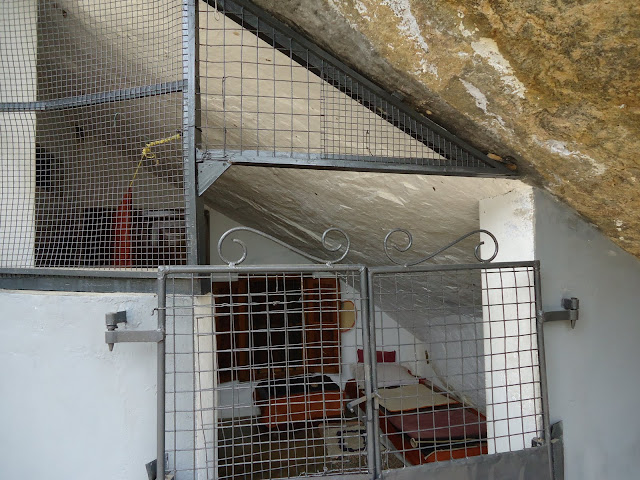Nimalawa Aranya, adjacent to the Nimalawa Sanctuary, is a forest based monastery, situated about 8 km off Thissamaharama town, in the Kirinda road. The calm ambience of the aranya - which is a branch of the Kalyana Yogashrama Sanstha - will undoubtedly awe anyone who visits it.
The history of the monastery runs millania. Approximately 2200 years ago, thousands of great arhaths including Arhath Dhammadinna chose this monastery as a place of residence. It still boasts of stone inscriptions, caves and ponds that were used by arhaths at the time and is commonly referred to as the 'Holy Land of Ruhuna'. One particular stone inscription makes specific reference to a grandson of King Mahanaga, who is believed to be King Kawantissa. Another stone inscription is evidence that Thalaguru Wehera - Arhath Dhammadinna resided in - is in fact Nimalawa Aranya.
 Unfortunately the aranya was overtaken by the forest, for hundreds of years, as the bhikkhus left it due to famines and other natural disasters.With unrelenting effort, Kadawedduwa Sri Jinawansa Thera had it reconstructed and was re-established as a monastery on December 23, 1950, with the presence of Mathara Sri Gnanarama Thera and five other Bhikkhus. Three new chambers - Meththa, Karuna and Dhamma Vichaya - were built on site and on July 18, 1951 were presented to four bhikkhus including Getamanne Wimalawansa Thera. It is now one of the most famous forest monasteries in the country, complete with a vihara,Akasa pagoda,library,Bo tree,etc. Moreover it consists of 16 caves including the Maharambhaka cave - which is believed to be the cave Arhath Dhammadinna used as his chamber.Its reputation is such that a dayaka has to be in the waiting list for two years to get an opportunity to give alms.There are more than 750 dayakas.
Unfortunately the aranya was overtaken by the forest, for hundreds of years, as the bhikkhus left it due to famines and other natural disasters.With unrelenting effort, Kadawedduwa Sri Jinawansa Thera had it reconstructed and was re-established as a monastery on December 23, 1950, with the presence of Mathara Sri Gnanarama Thera and five other Bhikkhus. Three new chambers - Meththa, Karuna and Dhamma Vichaya - were built on site and on July 18, 1951 were presented to four bhikkhus including Getamanne Wimalawansa Thera. It is now one of the most famous forest monasteries in the country, complete with a vihara,Akasa pagoda,library,Bo tree,etc. Moreover it consists of 16 caves including the Maharambhaka cave - which is believed to be the cave Arhath Dhammadinna used as his chamber.Its reputation is such that a dayaka has to be in the waiting list for two years to get an opportunity to give alms.There are more than 750 dayakas.
The Nimalawa Sanctuary - a total of 1065.85 ha - adjoining the Yala National Park, is home to a myriad of wildlife. The night jar, deer, Sambur and wild boar are a common sight in the area. Unfortunately Nimalawa, situated in the dry zone has a very arid climate, with only 550 mm of rain, which is restricted to only October, November and December. The whole area is subject to a severe drought every year during July, August and September. Although water is provided to the area by pipes, this is also cut off during the drought. Consequently human and beast alike, have to suffer during the drought. People have to walk for miles in search of water and carcasses of animals who have died of thirst is a frequent sight here in the Nimalawa sanctuary. Animals who enter villages in search of water become easy prey to humans.
The Nimalawa Aranya is also faced with dire conditions during the drought. Water service completely ceases during the dry season. The sandy soil of the area reduces absorption. Consequently ground water is not an option. There were no other natural water sources other than the stagnant ponds and lakes that completely dry up after just two months of drought. The bhikkhus have barely enough water to drink let alone wash.
To participate for alms giving at Nimalawa Aranya;
Contact person: Mr.Chandrapala
Telephone : 0473483700










Great job dear...
ReplyDeleteMay I go to this Aranaya without poya days.
ReplyDelete115prasanna@gmail.com
yes,you can go any day.To participate for alms giving, please contact Mr.Chandrapala
DeleteTelephone : 0473483700 for more details.
cheers
Is there residence for 10-precept nuns?
ReplyDeleteno
DeleteLiving ARAHATH VEN MAHANUWARA WAJIRABUDDHI THERO. www.pathtonibbana.org
ReplyDeleteLiving ARAHATH VEN MAHANUWARA WAJIRABUDDHI THERO. www.pathtonibbana.org
ReplyDeleteviru sha :
ReplyDeletestill alive ????
Hello Champika,
ReplyDeleteI would like to visit the monastery. Are we allowed to visit the kuti that Arahath Dhammadinna used to reside in?
Thank you.
Nandana Perera